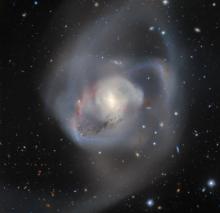Listen to today's episode of StarDate on the web the same day it airs in high-quality streaming audio without any extra ads or announcements. Choose a $8 one-month pass, or listen every day for a year for just $30.
You are here
Last Batch
Webb Space Telescope is getting ready to wrap up an ambitious early project: Cosmos-Web — the Cosmic Evolution Survey. It’s designed to tell astronomers about the very early universe.
It’s not easy to study that era. Earth’s atmosphere absorbs some of the wavelengths of light astronomers want to study. And earlier space telescopes haven’t been big enough to see that deeply into space very clearly. Webb combines a large telescope with instruments that are sensitive to the infrared wavelengths.
Cosmos-Web is looking for some of the earliest galaxies in the universe. It’s also looking at how dark matter was distributed when the universe was young, and much more.
The project is looking at a million galaxies, some of them as they looked just a few hundred million years after the Big Bang. Webb is scheduled to start the project’s third and final set of observations this month.
The viewing area covers three times the size of the full Moon. It’s in the middle of the area of a similar Hubble telescope project about 20 years ago. That area has few stars or clouds of gas and dust, making it easier for the telescope to see deep into the universe.
That area is along the celestial equator, in Sextans. The faint constellation climbs into view by midnight, to the lower right of the bright star Regulus, the heart of the lion. It’s a region that’s getting one more “deep look” by Webb Space Telescope.
More about the telescope tomorrow.
Script by Damond Benningfield





